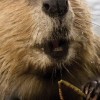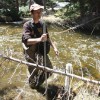My partner Matt and I left the Lupine Meadows parking lot in Grand Teton National Park at sunrise, his long stride covering miles quickly, my short stride moving fast to keep up. We paused at Amphitheater Lake for handfuls of trail mix and then, at the direction of the park ranger we’d spoken to the evening before, began to hunt for a faint trail that would lead us up the ridge east of the high alpine lake. In the basin beyond that ridge, we’d been told, sat a glacier.

We found the path in a cluster of boulders and followed it away from the lake. The steep incline required scrambling with all fours past scrubby pine trees. When we finally reached the ridge, we were disappointed: there was no glacier in sight.
Instead we saw piles of house- and car-sized boulders strewn along a valley floor. Beyond towered a horseshoe-shaped wall of debris. Rocks, silt, and boulders once carried by a glacier and then left behind, this moraine offered a clue. Maybe behind it we would find what we were looking for.
I was searching for Teton Glacier just as I’d been searching for glaciers all summer to gather material for my master of fine arts writing thesis at the University of Wyoming. My journey began in Alaska where I’d traveled by foot, floatplane, pack raft, and ski to glaciers in the Southeast and the Kenai Range. Next Matt and I visited a series of glaciers that became notably smaller as we moved south through Alberta, British Columbia, Montana, and, finally, Wyoming. I traveled to the glaciers not to measure them or to mourn the loss of ice, but simply to experience them and to record that experience for others.
I am a writer and a scientifically curious person. I’m drawn to glaciers because I feel most alive in hard, cold spaces, and have a fierce desire to tell a story not often told. Much of what the public knows about glaciers comes through media stories about climate change, rising sea levels, or how glaciated regions of the world are melting fast. But there is more to glaciers. Their decline shifts climate. Their decline changes ecosystems. And their decline also means the loss of incredibly bizarre and inspiring spaces on earth that few humans will ever experience first hand. My goal is to share the story—the ecological, climactic, and personal story—of these places.
Which is how I ended up picking my way down the steep slope into the valley alongside Matt, searching for one of the few glaciers still standing in the Teton range. We reached the boulder field and worked our way across it, pressing our feet and hands between car-sized granite chunks and scattered shreds of malachite. Water gurgled beneath us, unseen, hidden by a cluttered rock mess.
The boulder field steepened. Boulders gave way to sandy scree and rocks. The fluted moraine glittered in pale sunlight that cut through clouds above. We tipped our heads back to see the top of it 100 feet above us, hunched our shoulders and continued climbing. Rocks shifted beneath our boots with each slow, steady step. Occasionally we slid back as far as we’d moved forward.
Once atop the moraine ridge, we still couldn’t see the glacier, but we stood where it had once been. Before us a steep loose pitch slanted down to a large snow patch. We glissaded down the moraine and followed the snow to a sheer rock pillar. We rounded the pillar and an amphitheater opened before us.
I stopped and put my hand on Matt’s arm. The glacier sat tightly nestled against the lower reaches of the Grand Teton, Mount Owen, and Mount Teewinot. It filled a small corner of the amphitheater and spread 2000 feet or so to where we stood. Its bergschrund—a wide seam that forms where moving ice has pulled away from rock wall—sat high above the rest of the ice, a large slit pressed against the rock behind. The seam gave way to a miniature icefall, and to the right of the icefall, a small band of crevasses etched into dirty snow like ribs.
The glacier had all of the form and texture of a typical glacier, but in miniature.
Down slope from the icefall and the cracks, water trickled through soft ice studded with multicolored rock and punctuated the air with muffled, steady rhythms. The water slid beneath the debris horseshoe that stretched across the opening of the amphitheater, and far down slope, met a creek that gurgled and splashed through Glacier Gulch to the glittering, rich turquoise surface of Delta Lake.
I gazed up at the glacier and down to the lake and imagined ice filling the space as it did during the last Ice Age. This glacier, along with others in North America, is a remnant of the ice sheets that once stretched across the continent. As the climate shifted over the last 12,000 years, the ice sheets shrunk to glaciers and left mountain peaks and valleys in their wake. Some of the remaining glaciers still grow, most are declining, and some, like the Teton Glacier maintain their small mass thanks to northerly aspects, and protective cirque walls.
I come to these places to experience the earth as it was and to experience it as it is. Glaciers—especially these hidden ones burrowed in the Rocky Mountain West—illustrate the ever-changing nature of these landscapes. They are a living history, and someday—perhaps sooner than later—their presence and current shapes will exist only in text and photos on the pages of books. All we will know and experience of them is what they leave behind.
I smiled at Matt and squeezed his hand. He smiled back. We turned back toward the moraine and slowly began the climb out.
By Manasseh Franklin
Manasseh Franklin is pursuing a master of fine arts in creative nonfiction writing and environment and natural resources at the University of Wyoming. She has reported for magazines including Afar, Rock and Ice, Trail Runner, and others.


